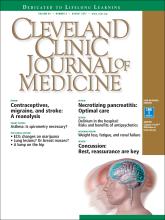ABSTRACT
Combined hormonal contraceptives are contraindicated in women who have migraine with aura, in whom these drugs can increase the risk of ischemic stroke. However, this contraindication is based on data from the 1960s and 1970s, when oral contraceptives contained much higher doses of estrogen. Stroke risk is not significantly increased with today’s preparations, many of which contain less than 30 μg of ethinyl estradiol. Further, in continuous regimens, ultra-low-dose formulations—those that contain less than 20 µg of ethinyl estradiol—may help prevent menstrual migraine and reduce the frequency of aura.
Footnotes
Dr. Calhoun has disclosed contracting, consulting, teaching, or speaking for Autonomic Technologies, Depomed, ElectroCore Medical, Eli Lilly, Merck, Scion NeuroStim, and Teva Pharmaceutical Industries.
- Copyright © 2017 The Cleveland Clinic Foundation. All Rights Reserved.
- Anne H. Calhoun, MD, FAHS
- Pelin Batur, MD, FACP, NCMP⇑
- Education Director, Primary Care Women’s Health, Cleveland Clinic
- Assistant Professor, Cleveland Clinic Lerner College of Medicine of Case Western Reserve University, Cleveland, OH
- ADDRESS:
Pelin Batur, MD, FACP, NCMP, Primary Care Women’s Health, Cleveland Clinic Independence Family Health Center, 5001 Rockside Road, IN30, Independence, OH 44131; baturp{at}ccf.org
ABSTRACT
Combined hormonal contraceptives are contraindicated in women who have migraine with aura, in whom these drugs can increase the risk of ischemic stroke. However, this contraindication is based on data from the 1960s and 1970s, when oral contraceptives contained much higher doses of estrogen. Stroke risk is not significantly increased with today’s preparations, many of which contain less than 30 μg of ethinyl estradiol. Further, in continuous regimens, ultra-low-dose formulations—those that contain less than 20 µg of ethinyl estradiol—may help prevent menstrual migraine and reduce the frequency of aura.
Footnotes
Dr. Calhoun has disclosed contracting, consulting, teaching, or speaking for Autonomic Technologies, Depomed, ElectroCore Medical, Eli Lilly, Merck, Scion NeuroStim, and Teva Pharmaceutical Industries.
- Copyright © 2017 The Cleveland Clinic Foundation. All Rights Reserved.






